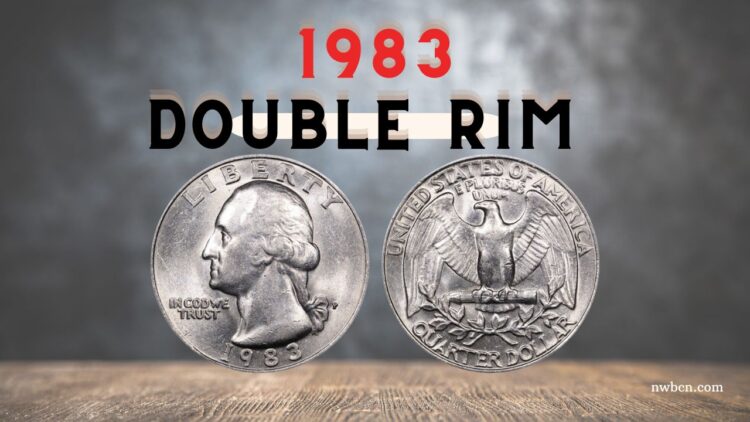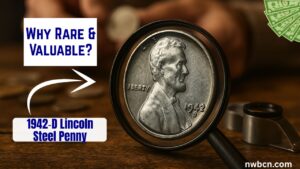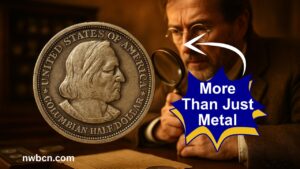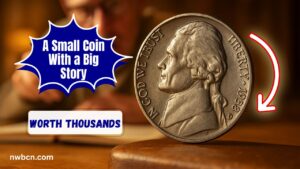Coin collectors are increasingly drawn to the 1983 Washington quarter, particularly versions with a double rim (also known as a railroad rim or finned rim).
Despite large mintages—over 1.2 billion combined from Philadelphia and Denver—these error coins now command attention due to their rarity, striking appearance, and modern grading trends.
The 1983 Quarter: Background & Production
Minting background
- Released in 1983 from Philadelphia (approx. 673 million) and Denver (approx. 618 million).
- Composition: standard copper-nickel clad (91.67% copper, 8.33% nickel).
- No general mint uncirculated sets were struck in 1982 or 1983—only souvenir sets sold at U.S. Mint visitor centers.
Design
- Obverse: Profile of George Washington with LIBERTY above, IN GOD WE TRUST to the left, and the date below.
- Reverse: Eagle with spread wings clutching arrows and an olive branch, with inscriptions UNITED STATES OF AMERICA and QUARTER DOLLAR.
Why a Double Rim Matters
In 1983 quarters, a double rim error—also referred to as a railroad rim—occurs when the collar die shifts or malfunctions.
This allows metal to squirt into the gap between the collar and the die, creating a raised extra rim or band around the edge.
Key traits:
- The rim appears thicker, layered, or doubled—resembling railroad tracks.
- These errors are highly sought after by collectors of U.S. mint error coins.
- The absence of standard uncirculated sets in 1983 makes mint-state examples especially valuable.
Other Notable 1983 Errors
Collectors also look for these error varieties:
- Off‑Center Strikes (typically 50–55% off): Valued between $50–$100+ depending on visibility.
- Spitting Eagle (Die Clash): A line appears below the eagle’s beak, mimicking spit. Value can range from $1 to $500+, especially in grades MS66 and above.
- Struck on a Nickel Planchet: These coins are lighter and slightly smaller than normal, and can fetch $180–$260 or more.
- Reverse Indent Errors: Planchet indents on the reverse side can command prices of $310+.
- Double Die and Die Deterioration Doubling: Coins such as the 1983‑D “Type 2 DDR” with sharp doubled letters add layered value.
These errors highlight the minting inconsistencies of the early 1980s and underscore why the double rim variety stands out among error coins.
Value Drivers for the 1983 Double Rim Quarter
| Feature | Why It Matters | Typical Value Impact |
|---|---|---|
| Double Rim (Railroad Rim) | Rare collar misstrike—visually obvious and collectible | Circulated: $10–$50; Uncirculated: $50–$200+ |
| Mint State Grade | Higher grades boost collectibility and market value | Up to $150–$400+ |
| Additional Errors Present | When combined with other anomalies like die clash or off-center strike | Premium: $100–$500+ |
| Mint Location | Denver (D) mint errors can command 2–3x the value of Philadelphia (P) coins | MS67+ D: Up to $1,400+ |
| Scarcity of Souvenir Sets | No regular mint sets for 1983 increases demand for uncirculated coins | Higher premiums for mint-state pieces |
| Collector Trends | Modern fascination with error coins has boosted interest and market activity | Demand drives steady appreciation in value |
Recent Sales & Market Trends
- A 1983‑P MS65 souvenir set coin with a double rim reportedly sold for over $15,800.
- A high-grade 1983‑D MS67 (no error) sold for around $1,410, showing the value of pristine coins even without errors.
- Coins graded MS66 and above with double rims and/or multiple errors consistently trade between $150–$500+.
- Online marketplaces show raw (uncertified) double-rim examples listed for $10–$50, though prices vary based on condition and clarity of the error.
Clearly, both the market demand and grading level play major roles in determining the coin’s worth.
Grading Importance & Detection
Professional grading services like PCGS and NGC significantly influence a coin’s value by authenticating and certifying its condition.
Value by Grade (with double rim):
- MS60–MS63: Typically valued between $50–$150.
- MS65–MS67: Premiums increase sharply, reaching $200–$1,500+.
How to detect a double rim:
- Examine the coin’s edge under bright lighting or magnification.
- Look for two distinct raised rim levels—the second rim is typically flatter or broader.
- Use a loupe or magnifying glass to compare with standard rim examples.
Why Modern Collectors Care
The appeal of the 1983 double rim quarter goes beyond its error:
- False assumption of abundance: Despite high production numbers, genuine double rim errors are rare.
- No uncirculated mint sets in 1983: Increases the demand for well-preserved, error-laden examples.
- Visually dramatic: The rim doubling makes it a standout for collectors who value aesthetics.
- Layered rarity: Some coins exhibit multiple errors, like off-center strikes and planchet flaws.
- Influence of social media and YouTube: Modern platforms have amplified awareness and desirability of U.S. error coins.
Collector Buzz and Community Impact
Collector forums, blogs, and video platforms have sparked a new wave of enthusiasm for the 1983 error quarters. From Reddit threads identifying rim anomalies to professional grading submissions showcasing high-value results, this coin has found a renewed following.
- Some online posts label the double rim quarter as a “hidden treasure in your change.”
- Community members frequently share finds, ask for verification, and debate grading decisions.
- Sales listings reflect the growing trend—coins once overlooked now list for hundreds of dollars, even without slabbed certification.
How to Find and Verify One
If you’re curious about finding a 1983 double rim quarter, here are some helpful steps:
- Inspect your spare change: Many valuable error coins are still found in circulation.
- Check coin rolls: Bank-issued rolls offer a greater chance to find rare pieces in bulk.
- Use a magnifier: Edge errors like the double rim are sometimes subtle and require close-up viewing.
- Consider professional grading: A certified error in MS condition can multiply a coin’s worth severalfold.
Collectors often note that coins featuring both double rims and die clash or off-center strike combinations bring the highest premiums.
Tips for Collectors
- Buy from trusted sources: Ensure authenticity when purchasing raw or uncertified error coins.
- Document your find: Photographs and written condition notes help when seeking grading or resale.
- Track market trends: Monitor online auction platforms to understand what collectors are currently paying.
- Store coins carefully: Protect rims and edges with proper holders to preserve the error’s visibility.
- Consider full error sets: Building a mini-collection of 1983 error quarters (e.g., double rim, off-center, die clash) increases resale value.
The 1983 quarter with a double rim is an exciting example of how minting quirks and historical gaps can transform a common coin into a prized collectible.
Its scarcity, combined with visual appeal and the absence of traditional mint sets that year, makes it particularly attractive to collectors today.
Whether you’re an experienced numismatist or a beginner sifting through change, discovering a double rim quarter could be a surprising and valuable find.
With continued interest from the coin-collecting community and a growing spotlight in online marketplaces, the 1983 double rim quarter is securing its place as a modern American rarity.
FAQs
1. What does a double rim on a 1983 quarter look like?
A double rim appears as an extra raised band along the edge of the coin, forming a second outer layer. It is often visible to the naked eye but clearer under magnification.
2. Are 1983 double rim quarters common?
No. While over a billion quarters were produced in 1983, only a small number exhibit the double rim error, making them rare and collectible—especially in uncirculated condition.
3. How much is a 1983 double rim quarter worth?
The value ranges from $10–$50 for circulated examples and $150–$500+ for higher grades. If combined with other errors or slabbed by a grading service, the coin may fetch over $1,000.




